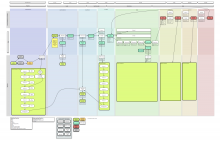Challenge
Every organization has or needs a CRM system. If you already have one, chances are it’s not setup properly. You are probably experiencing low adoption of processes, poor data quality, and unreliable reporting. If you don’t have a CRM system yet, you might be worried about implementation questions. It’s challenging to have to select and configure fields, design reporting, customize workflow, and train your staff. And then, how are you going to migrate all that data from spreadsheets?
Solution and Benefits
The CRM system should be your marketing and sales hub. This means that all marketing and sales processes, workflow, data, and reporting go through the CRM system. And the CRM system is the system of record for all marketing and sales data. At Synaxis, we can help you configure, implement, or optimize your CRM system so that’s possible. When we’re done, your CRM system will be a key part of your marketing and sales operations. And you will be able to run reliable reports and gather accurate data from the system.
Approach
Implementing, configuring, or optimizing a CRM system involves 3 steps:
- First, we work with you to understand your organization and gather your requirements.
- Then, we can set the system to suit these needs.
- Once this is complete, we can help you rollout the system to your organization.
Gathering Requirements and Planning
 First, we work with you to understand your organization and gather your requirements. and then adapting our best practices to meet your individual needs. This takes several steps:
First, we work with you to understand your organization and gather your requirements. and then adapting our best practices to meet your individual needs. This takes several steps:
- Review current marketing and sales processes—all improvement begins with a realistic assessment of the current state of your marketing and sales operations. We like to review anything we can to learn how things are working right now. This can include interviews, observation, and reading manuals and documentation.
- Discuss goals and plans for the marketing and sales teams—the sales and marketing teams are going to be directly affected by this work, and we need their interest, support, and ultimately cooperation. Besides that, the marketing and sales teams always have a great deal of interesting and helpful ideas about how to improve the system
- Refine or redesign the marketing and sales processes—if your processes need to be enhanced, we can compare your current operations to our best practices library. This allows us to provide you with proven, high performing systems while preserving what’s unique about your organization.
- Document processes—the final step in the process is to thoroughly document all the new processes and changes. The goal is to capture the design of the future state.
This phase assumes that everything “works”, so it serves as much as a roadmap for training as for for the rest of the work. Once this phase of the work is complete, you will have a good understanding of what needs to get implemented and why.
Installing and Configuring
With the documented future state in hand, we can set the system to suit these needs. Depending on the requirements, this can mean several different kinds of work:
- Adding and customizing objects or modules
- Adding and customizing fields
- Developing views and layouts
- Designing reports
- Data migration and integration (if you have legacy systems that need to be retired)
Rolling Out
Once this is complete, we can help you rollout the system to your organization. This means much more than just “flipping the switch”. Rather, we make sure that the right teams have the right documentation. Beyond that, we can provide live, online, or hands-on training for teams or individuals. When we do training, we like to record the session. This allows these events to be assets for future on-boarding of marketing and sales staff. Once training is complete, we can track and monitor adoption and offer revised documentation or refresher training, as needed.
